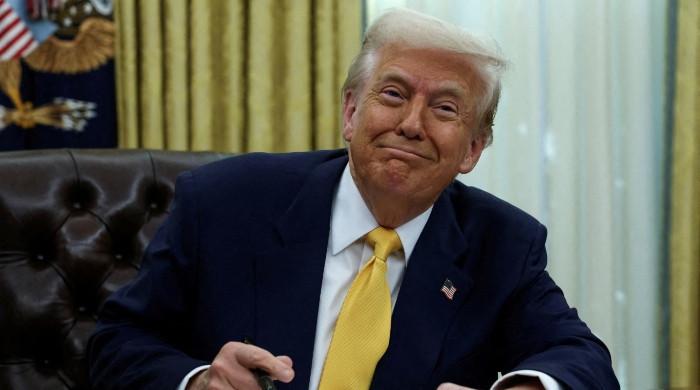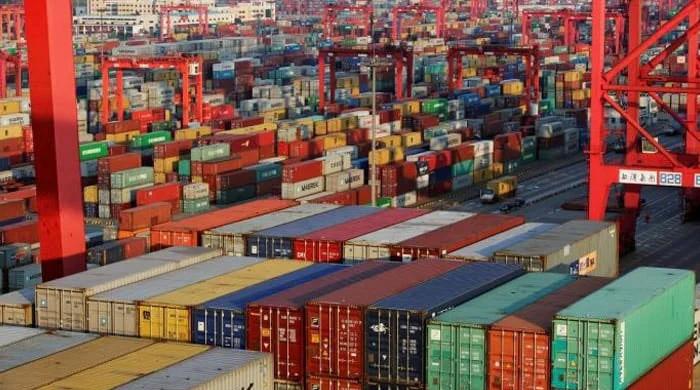Shares bruised, dollar crumbles as Trump tariffs stir recession fears
Asian shares struggled to recover their heavy losses from the previous session
April 04, 2025

- Stocks struggle after global selloff on Trump's tariffs.
- Investors fear US recession, ramp up bets on Fed rate cuts.
- Safe-haven assets rise; gold near record high, dollar weakens.
Stocks limped to the end of the week on Friday, the dollar was set for its worst week in a month while gold flirted with a record peak as investors feared US President Donald Trump's sweeping tariffs would tip the global economy into a recession.
Asian shares struggled to recover their heavy losses from the previous session as Japan's Nikkei, opens new tab fell 1.85%, extending its 2.8% slide from Thursday.
MSCI's broadest index of Asia-Pacific shares outside Japan, opens new tab dipped 0.26% in thin trade, with markets in China, Hong Kong and Taiwan closed for a holiday.
Overnight S&P 500 companies lost a combined $2.4 trillion in stock market value, their biggest one-day loss since the coronavirus pandemic hit global markets on March 16, 2020, while other Wall Street indexes similarly clocked sharp falls.
The bruising selloff across markets came after Trump on Wednesday announced Washington's steepest trade barriers in more than 100 years, sending investors scrambling for safety assets.
"If the current slate of tariffs hold, a Q2 or Q3 recession is very possible, as is a bear market," said David Bahnsen, chief investment officer at The Bahnsen Group.
"The question is, does President Trump seek some sort of off-ramp for these policies if and when we see a bear market in the stock market. We believe Trump will then pivot to focus on the number of companies that are making significant investments in the US., but it's unclear that would reverse market sentiment."
US stock futures steadied in the early Asian session, with Nasdaq futures rising 0.05%, while S&P 500 futures eased 0.06%.
Reflecting the heightened worries of a global recession, particularly in the United States, traders have since ramped up bets of more Federal Reserve rate cuts this year, on the view that policymakers would have to ease more aggressively to shore up growth in the world's largest economy.
Fed funds futures now point to roughly 96 basis points worth of cuts by December, from closer to 70 bps shortly before Trump's tariffs were announced on Wednesday.
"Central banks are not well-equipped to deal with stagflation as the impacts of slower growth and higher inflation pull policy in opposing directions," said David Doyle, head of economics at Macquarie Group.
"This means that stronger core inflation is likely to limit the extent of any policy response from the Fed due to the headwinds created for growth."
Fed Chair Jerome Powell is due to speak later on Friday and investors will be looking out for his latest assessment of the US economy and any clues on the policy outlook following Trump's fresh tariff salvo.
In the foreign exchange market, the dollar was up 0.09% against the yen at 146.23, after having tumbled 2.2% in the previous session, its steepest daily fall in more than two years.
The euro steadied at $1.1043 after a 1.9% jump on Thursday, while the Swiss franc last stood at 0.8591 per dollar, having also surged 2.6% on Thursday.
Against a basket of currencies, the dollar languished near a six-month low at 102.04.
"Much of the weakness of the US dollar this year can be related to the weight of long positions that were built into the end of the year coupled with the refocussing of attention on US growth risks that have accompanied tariff talk for weeks," said Jane Foley, senior FX strategist at Rabobank.
Safe-haven currencies like the yen and the Swissie have benefitted from investors' flight to safety assets, which also saw bond prices surging.
The benchmark 10-year US Treasury yield was last little changed at 4.0436%, having fallen 14 bps in the previous session. Bond yields move inversely to prices.
Elsewhere, spot gold was perched near a record high at $3,112.81 an ounce, and was on track for a fifth straight weekly gain, as worries about the impact of Trump's tariffs on the global economy boosted the metal's safe-haven appeal.
Oil prices extended their steep decline from the previous session, with Brent futures down 0.13% at $70.05 a barrel, while US West Texas Intermediate crude futures fell 0.15% to $66.85 per barrel.











